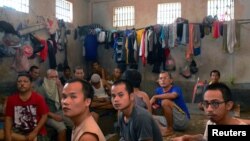The visiting room at Kerobokan Correctional Facility in Bali is usually full in the morning until noon on weekdays, when families and friends are allowed to visit. About 15 inmates were standing from behind bars and talking to their guests on the other side.
Amalia, not her real name, was visiting her son to bring him lunch on Thursday last week. He was recently incarcerated for getting into a fight in Denpasar, the capital of Bali. She complained that the Kerobokan Prison is overcrowded.
“I think they have too many prisoners, but other than that the condition is alright. My son said the wardens are friendly,” she said without disclosing her son’s name for security reasons.
Kerobokan prison now hosts more than 1,700 people in a facility that was designed for 323 inmates. The Governor of Bali, I Wayan Koster, told the media during a visit to the prison at the end of April that the government is trying to find a solution.
“I think we need to relocate, this is no longer feasible,” he stated.
Meanwhile in Cipinang Correctional Facility in Jakarta, there are more than 2,900 inmates in a building that is supposed to accommodate only 880. Other facilities suffer from the same condition, according to the Directorate General of Correctional at the Indonesian Ministry of Law and Human Rights, there are 265,574 incarcerated people while the facilities across Indonesia only has the capacity for 126,963.
Drug cases as biggest contributor
According to Genoveva Alicia, a researcher from the Institute of Criminal and Justice Reform (ICJR), overcrowding in prisons in Indonesia can be categorized as extreme and the problem occurs in almost all provinces in Indonesia.
“It’s not only a problem in the big cities, on average the overcrowding is more than 99 %. Only in six areas, including Yogyakarta the problem is not as bad,” she said.
Alicia cited one of the reasons for the overcapacity of correctional facilities in Indonesia is because in the judicial system, it is easy for people to end up in jail and stay less than one year. But the biggest contributors of the prison population are those who were involved in a drug case.
Ade Kusmanto, the head of Public Relations at the Directorate General of Correctional, said drug cases make up around 48 percent of all criminal activities. There are more than 127,000 incarcerations due to drugs. Out of that number 75,000 are dealers and 51,000 are users.
“I’m hoping the politics of law will change in dealing with drug cases, so that users will not be sentenced to jail. It can be alternative punishment such as rehabilitation or community service while they are being rehabilitated,” he told VOA.
Drug crime in Indonesia is regulated under the law no. 35/2009 on drugs. While the law stated that users should be rehabilitated, oftentimes they end up in jail for drug possession. Kusmanto mentioned it was also because rehabilitation for drug users has not been fully applied, law enforcement usually resorts to a prison sentence.
“If these (drug) users are given alternative sentencing, other than prison, imagine how many of them would be out of jail,” he added.
Alternative non-custodial sentences
Alicia said to solve the problem of prison overcapacity, the government should be prepared to give alternative punishment other than prison time. She believes that Indonesia already has a system for non-custodial sentences, such as fine, probation or community services, which can be applied to less severe crimes with no victim.
“But the problem is, these alternatives are not being utilized. We have a problem in resources, with the institutions, and also with technical regulation,” she told VOA. The only thing that has been running well for the law enforcement is jail sentencing.
“That’s why in their minds, you can only punish people by putting them in correctional facilities,” Alicia added.
Kusmanto admitted there is a lack of human resources which would make it difficult for the law enforcement to give out alternative punishment. He gave an example with probation after serving prison time. The parole officers have to cover such a big area with too many parolees that it becomes difficult for them to supervise everyone.
“We have limited number of officers, meanwhile there are a lot of parolees they have to visit one-by-one. Make sure they are behaving well,” he said.
Revitalization of correctional facilities
Kusmanto said the Indonesian Minister of Law and Human Rights, Yasonna Laoly, issued a ministerial decree no. 35/2018 on revitalization of correctional facilities in Indonesia. The Directorate General will also reduce overcrowding by evenly distributing the number of inmates from one facility to other neighboring facilities that are less full.
“And we will focus on changing the behavior of inmates and provide them with services such as counseling and guidance, to prevent them from going back,” he explained. Kusmanto added that with the new decree, other institutions including the law enforcement and other ministries will work together to find a solution.
But Alicia said the problem cannot be solved if the government does not start to think about non-custodial alternatives.
“We’re talking about input and output, even if all region has a facility, if we don’t regulate the input the number will never be reduced. The government should think about the alternative,” she said.








